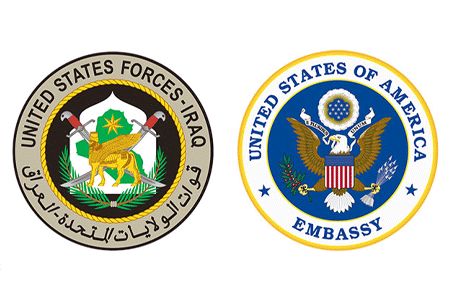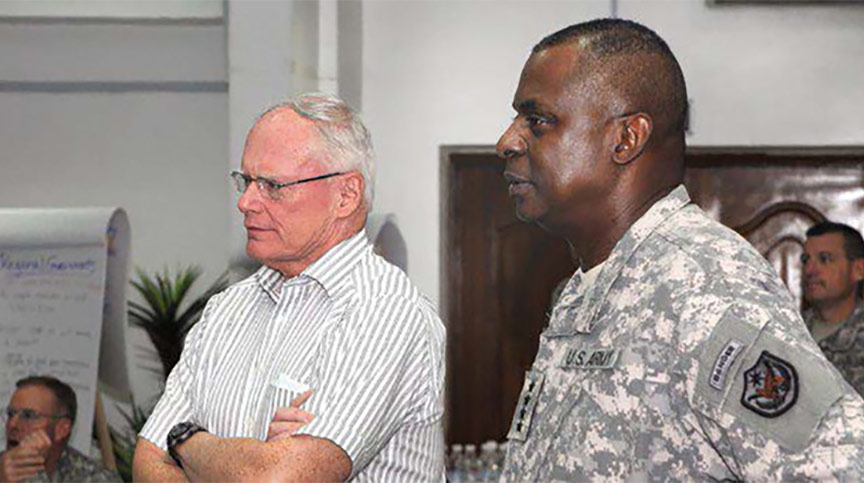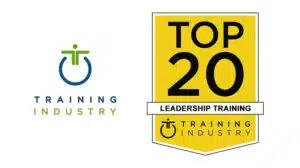- Case Study
- : Government, Aerospace & Defense
Boundary Spanning in a High-Pressure, High-Stakes Environment

| CLIENT: | U.S. State Department and U.S. Department of Defense |
| LOCATION: | Iraq |
| SIZE: | Tens of thousands of U.S. military and civilian personnel |
Client Profile & Challenge
On September 1, 2010, the United States launched Operation New Dawn in Iraq. After 8 years of combat, the U.S. planned to completely remove all military troops and transition U.S. leadership in Iraq from the military to the State Department no later than December 31, 2011.
Simultaneously, the U.S. would continue to work to stabilize the fledgling Iraqi democracy and strengthen the country’s security forces in an environment still marked by ethnic strife and active insurgencies. The ambitious plan had an equally ambitious timeline: just 16 months.
The Ambassador to Iraq, James Jeffrey, and General Lloyd Austin were responsible for carrying out Operation New Dawn. They knew that to be successful, the State Department and U.S. military had to collaborate seamlessly, despite having very different organizational cultures.
“Our 2 organizations really do have different DNA, and left to their own devices, they would work at cross-purposes,” Austin says. “We had to understand how we were different as organizations, but also different as individuals within the organizations,” Jeffrey notes. “That was the first step to ensuring that the 2 organizations could deal cooperatively with each other and, to some degree, meld together to meet the mission.”
If successful, Austin and Jeffrey would accomplish U.S. policy goals in Iraq and provide a tangible example to Iraqi leaders of how to overcome conflict, bridge differences, and achieve common goals.

Solution & Results
Austin and Jeffrey wanted to create a team of senior military and diplomatic leaders to ensure that the U.S. would speak with “one voice.” They faced 3 challenges: Identifying the differences between civilian and military leaders, spanning the boundaries that divided the 2 groups, and creating high-performing, collaborative teams.
“I knew we had to build a team of teams with the ambassador and the embassy,” Austin says. “If we worked at cross-purposes, it would be nearly impossible to accomplish both of our mission sets.”
The general and ambassador decided to build capacity for collaboration through a “Combined Vision Development Seminar” for the senior division commanders, general officers, and counselor-level embassy personnel. The seminar was to jump-start the process of becoming a “team of teams.” In a single 14-hour day, the goal was to create a framework for how the 2 organizations would achieve the unity of effort required for the mission.
We flew a 6-person delivery team to Iraq and into the Baghdad conflict zone to conduct interviews in both organizations and facilitate the seminar.
During the seminar, the participants from Defense and State learned about 3 key boundary-spanning strategies: Managing boundaries, forging common ground, and discovering new frontiers.
- Managing boundaries: To span boundaries, you must first see them clearly and understand how groups are different to then build safety and respect;
- Forging common ground: Finding what is universal and shared brings groups together to achieve a larger purpose; and
- Discovering new frontiers: Discovering similarities and differences fuels the “team of teams” by differentiating expertise, experience, and resources while being driven by an integrated vision and strategy.
“After the seminar, we set up a relatively rigorous and planned-out system,” Jeffrey says. That included a set of practices and a mindset to drive close collaboration, including:
- Twice-weekly in-person meetings between the ambassador and the general, alternating between the military headquarters and the embassy;
- A collaborative mindset that made inclusion, openness, and over-communication necessary and expected throughout the ranks and across the system;
- A one-voice approach to communications with Washington, Iraqi authorities, and other stakeholders in Iraq; and
- Viewing their differences as positive, so everyone understood that State and Defense’s strengths and weaknesses complemented and supported each other.
“I think we played upon each other’s talents in this way and really capitalized on strengths,” Austin says.
A year after the launch of New Dawn and the Combined Vision Development Seminar, both leaders said their mission remained on track. A seamless ethos of collaboration had been maintained between State and Defense, and Iraq had experienced significant economic, government, and security wins.
These dramatic changes came about in the face of what Jeffrey describes as a “no-kidding, ultra-hard mission.”
He says that by working together, “we’ve been able to carry out the plan that looked so daunting.”
Austin adds that the unit-of-effort, team-of-teams approach made “us twice as powerful as we would have otherwise been.”
Partner With Us
We’ve been delivering leadership development programs for the government sector for decades. We can help guide you and your government organization through times of disruption – and the transformed future that lies ahead.
| What to Explore Next
| Related Solutions
Sign Up for Newsletters
Don’t miss a single insight! Get our latest cutting-edge, research-based leadership content sent directly to your inbox.






